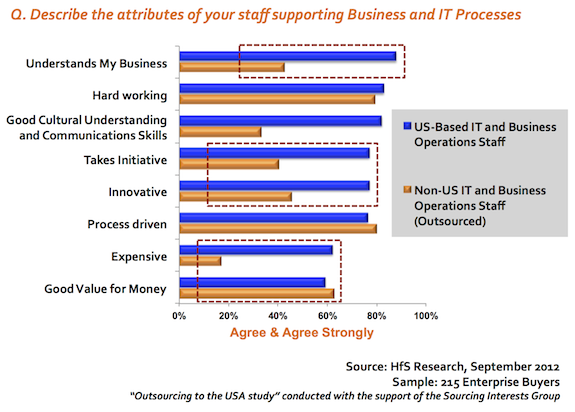


Rarely has a debate aroused so many emotions, yet failed to reach any conclusions, which was precisely what transpired when 900 of us duked it out over whether to drop the term “Outsourcing”. However we view this debate, outsourcing is centered predominantly on one constant: talent.
Talent costs money and brings capability. Outsourcing is about helping enterprises get better capability without increasing costs. It’s about tinkering with enterprises’ talent bases to deliver improved services without increasing costs. So how – pray tell – can enterprises improve their talent without going through the considerable expense of hiring new people and training their existing staff? The answer is simple: find someone else to help you do it – and good luck with it!
Of course, better workflow and process, better quality and innovation are vital ingredients to achieve greater productivity and increased revenues, but you have to start with the most critical ingredient: your talent.
If the industry known as outsourcing can prove consistently over time it can improve clients’ access to talent and new capabilities without increasing costs, then we won’t call it “outsourcing” any more, we’ll just call it “IT”, or “Finance”, or “Insurance” (and so on) services. However, when the central component of the industry is to swap out local staff with foreign staff, the first question the general public (92% of whom – in the US – are actually employees) will ask is “Can these people do IT, finance or insurance better than we can”.
Fortunately, HfS has been able to reach out to close to 700 key stakeholders in the industry, 215 of whom are from predominantly large-sized US corporations, where we were able to ask them how they rated the attributes of their local talent to the overseas talent being provided by their service provider:

In terms of work ethic, process competency and overall value for money, service providers’ non-US staff are matching the local staff. If these staff are 30-50% cheaper, that’s a pretty good return on your investment if that’s all you really care about.
In terms of business understanding, initiative, innovation and culture, the non-US staff being provisioned are miles behind local staff. For example, only 43% of buyers feel their non-US staff understands their business, when compared to 88% of local staff. Yes, this gap will surely close as the industry matures, but I find this talent-chasm unacceptable in today’s global marketplace.
The Final Word: Service providers need to improve their talent mix and use more local talent, however, buyers need to demand it
Outsourcing has earned a largely crappy reputation because it’s become so focused on providing rules-based models that can enable offshore staff to get the job done. Many clients, for whatever reason, have been convinced they can do this with 90% of their delivery staff sitting offshore, or some simply didn’t care and wanted to make the numbers work.
However, our research clearly tells us that most clients care passionately about innovation and process improvement, so why are we persisting with these imbalanced delivery models, where the outcomes are performing miles from what we want to be? Why aren’t today’s buyers training their own staff to manage their global resources more effectively, so that more of them do understand their businesses? Why are service providers so insistent on sending offshore managers onto their clients’ sites to manage their own staff, when they should be training their clients to be more self-sufficient?

